Auditing Report: Analysis of EML Financial Statements and Audit
VerifiedAdded on 2023/01/17
|10
|2338
|57
Report
AI Summary
This report provides a comprehensive analysis of an auditing assignment focused on EML's financial statements. It explores the audit expectation gap, the responsibilities of auditors and the Board of Directors, and the advantages and disadvantages of voluntary audits. The report examines the requirements for EML to be audited, the obligations of the auditors, and the issues that auditors need to take into account, including going concern status and the management's attitude toward financial reporting. It also outlines the steps required for appointing new auditors and the importance of adhering to XRB standards. The report highlights the benefits of audited financial statements, such as increased credibility and reduced fraud, and the legal requirements for audit engagement and reporting.

Running head: AUDITING
Auditing
Name of the Student
Name of the University
Author’s Note
Auditing
Name of the Student
Name of the University
Author’s Note
Paraphrase This Document
Need a fresh take? Get an instant paraphrase of this document with our AI Paraphraser
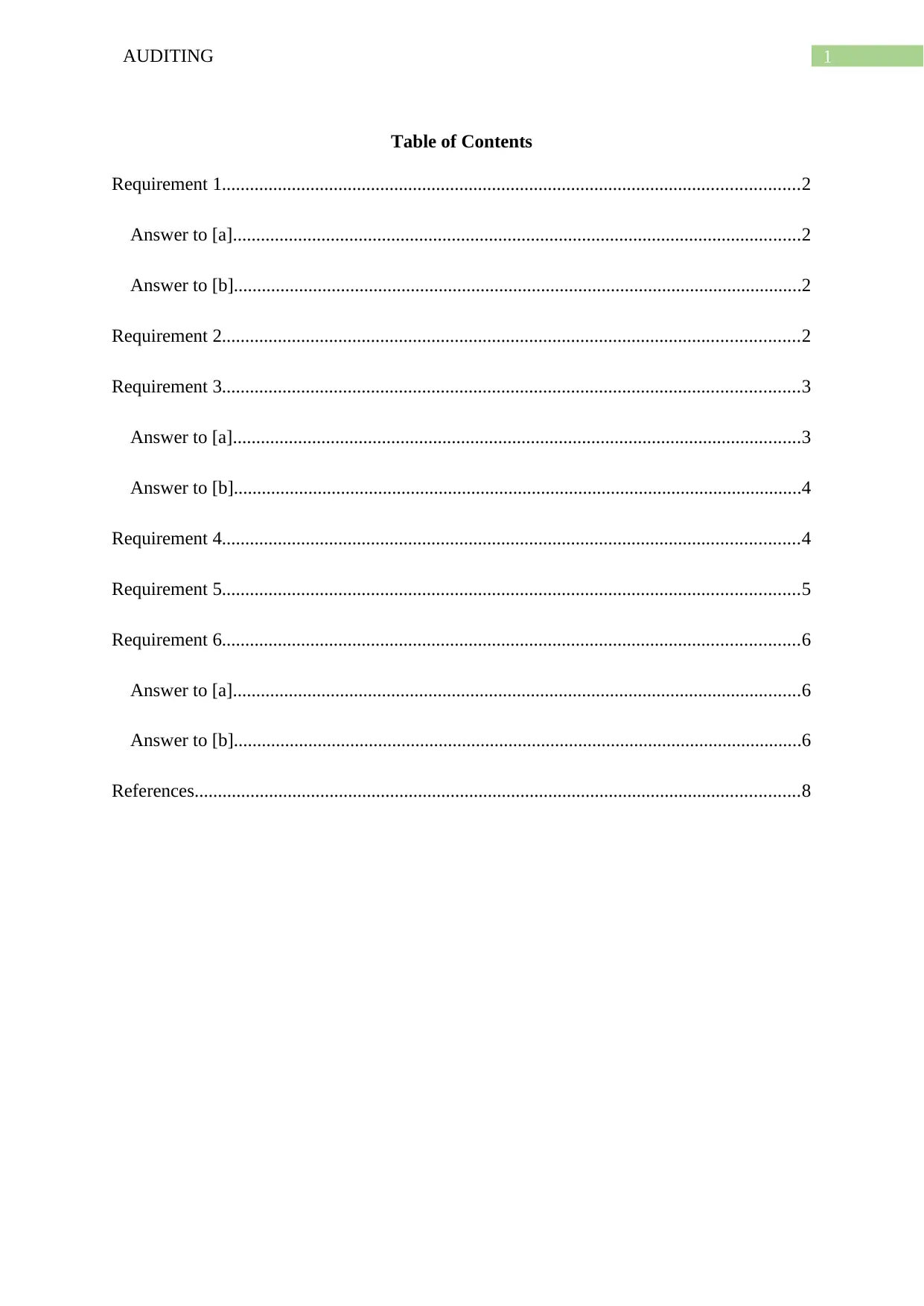
1AUDITING
Table of Contents
Requirement 1............................................................................................................................2
Answer to [a]..........................................................................................................................2
Answer to [b]..........................................................................................................................2
Requirement 2............................................................................................................................2
Requirement 3............................................................................................................................3
Answer to [a]..........................................................................................................................3
Answer to [b]..........................................................................................................................4
Requirement 4............................................................................................................................4
Requirement 5............................................................................................................................5
Requirement 6............................................................................................................................6
Answer to [a]..........................................................................................................................6
Answer to [b]..........................................................................................................................6
References..................................................................................................................................8
Table of Contents
Requirement 1............................................................................................................................2
Answer to [a]..........................................................................................................................2
Answer to [b]..........................................................................................................................2
Requirement 2............................................................................................................................2
Requirement 3............................................................................................................................3
Answer to [a]..........................................................................................................................3
Answer to [b]..........................................................................................................................4
Requirement 4............................................................................................................................4
Requirement 5............................................................................................................................5
Requirement 6............................................................................................................................6
Answer to [a]..........................................................................................................................6
Answer to [b]..........................................................................................................................6
References..................................................................................................................................8
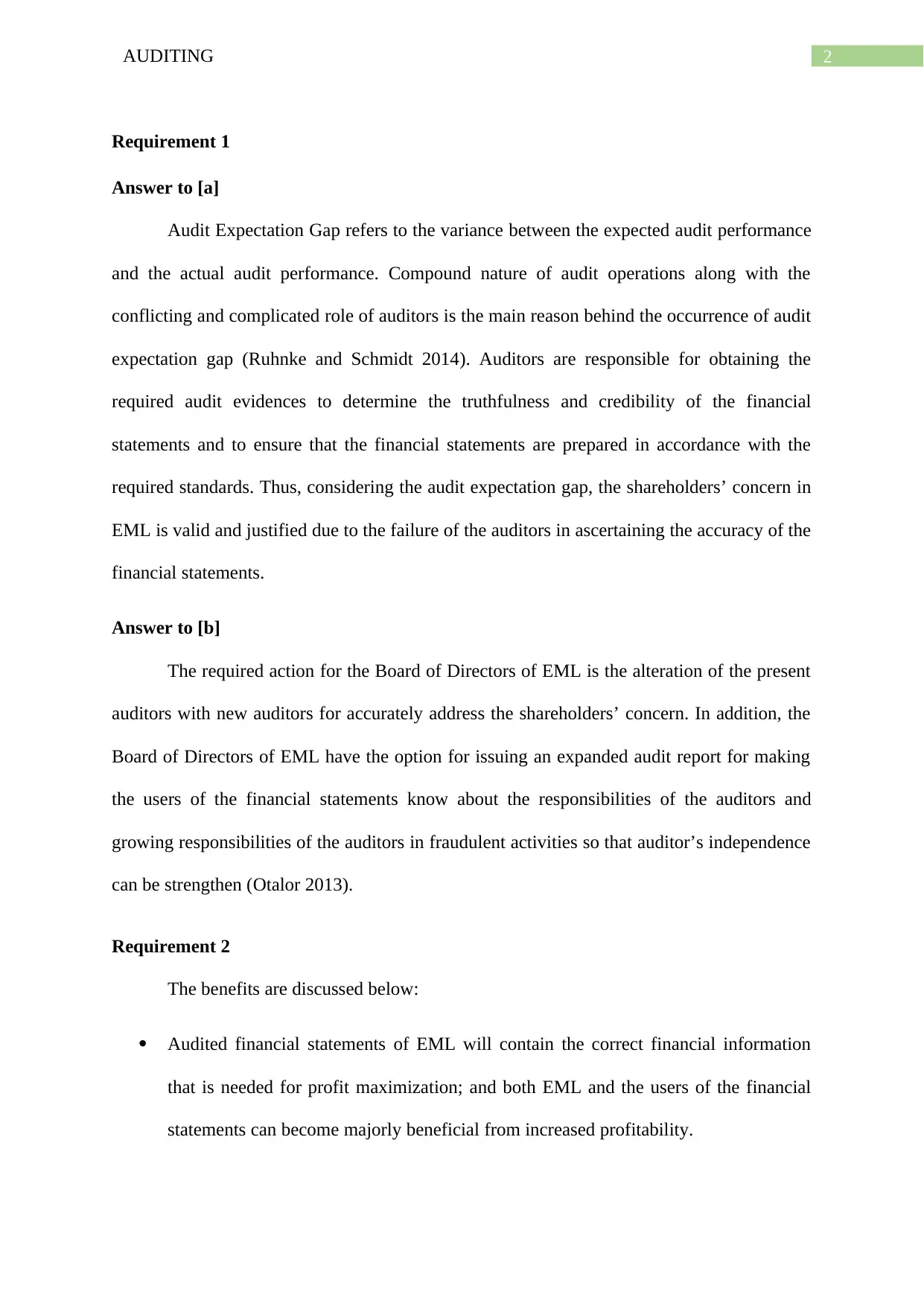
2AUDITING
Requirement 1
Answer to [a]
Audit Expectation Gap refers to the variance between the expected audit performance
and the actual audit performance. Compound nature of audit operations along with the
conflicting and complicated role of auditors is the main reason behind the occurrence of audit
expectation gap (Ruhnke and Schmidt 2014). Auditors are responsible for obtaining the
required audit evidences to determine the truthfulness and credibility of the financial
statements and to ensure that the financial statements are prepared in accordance with the
required standards. Thus, considering the audit expectation gap, the shareholders’ concern in
EML is valid and justified due to the failure of the auditors in ascertaining the accuracy of the
financial statements.
Answer to [b]
The required action for the Board of Directors of EML is the alteration of the present
auditors with new auditors for accurately address the shareholders’ concern. In addition, the
Board of Directors of EML have the option for issuing an expanded audit report for making
the users of the financial statements know about the responsibilities of the auditors and
growing responsibilities of the auditors in fraudulent activities so that auditor’s independence
can be strengthen (Otalor 2013).
Requirement 2
The benefits are discussed below:
Audited financial statements of EML will contain the correct financial information
that is needed for profit maximization; and both EML and the users of the financial
statements can become majorly beneficial from increased profitability.
Requirement 1
Answer to [a]
Audit Expectation Gap refers to the variance between the expected audit performance
and the actual audit performance. Compound nature of audit operations along with the
conflicting and complicated role of auditors is the main reason behind the occurrence of audit
expectation gap (Ruhnke and Schmidt 2014). Auditors are responsible for obtaining the
required audit evidences to determine the truthfulness and credibility of the financial
statements and to ensure that the financial statements are prepared in accordance with the
required standards. Thus, considering the audit expectation gap, the shareholders’ concern in
EML is valid and justified due to the failure of the auditors in ascertaining the accuracy of the
financial statements.
Answer to [b]
The required action for the Board of Directors of EML is the alteration of the present
auditors with new auditors for accurately address the shareholders’ concern. In addition, the
Board of Directors of EML have the option for issuing an expanded audit report for making
the users of the financial statements know about the responsibilities of the auditors and
growing responsibilities of the auditors in fraudulent activities so that auditor’s independence
can be strengthen (Otalor 2013).
Requirement 2
The benefits are discussed below:
Audited financial statements of EML will contain the correct financial information
that is needed for profit maximization; and both EML and the users of the financial
statements can become majorly beneficial from increased profitability.
⊘ This is a preview!⊘
Do you want full access?
Subscribe today to unlock all pages.

Trusted by 1+ million students worldwide
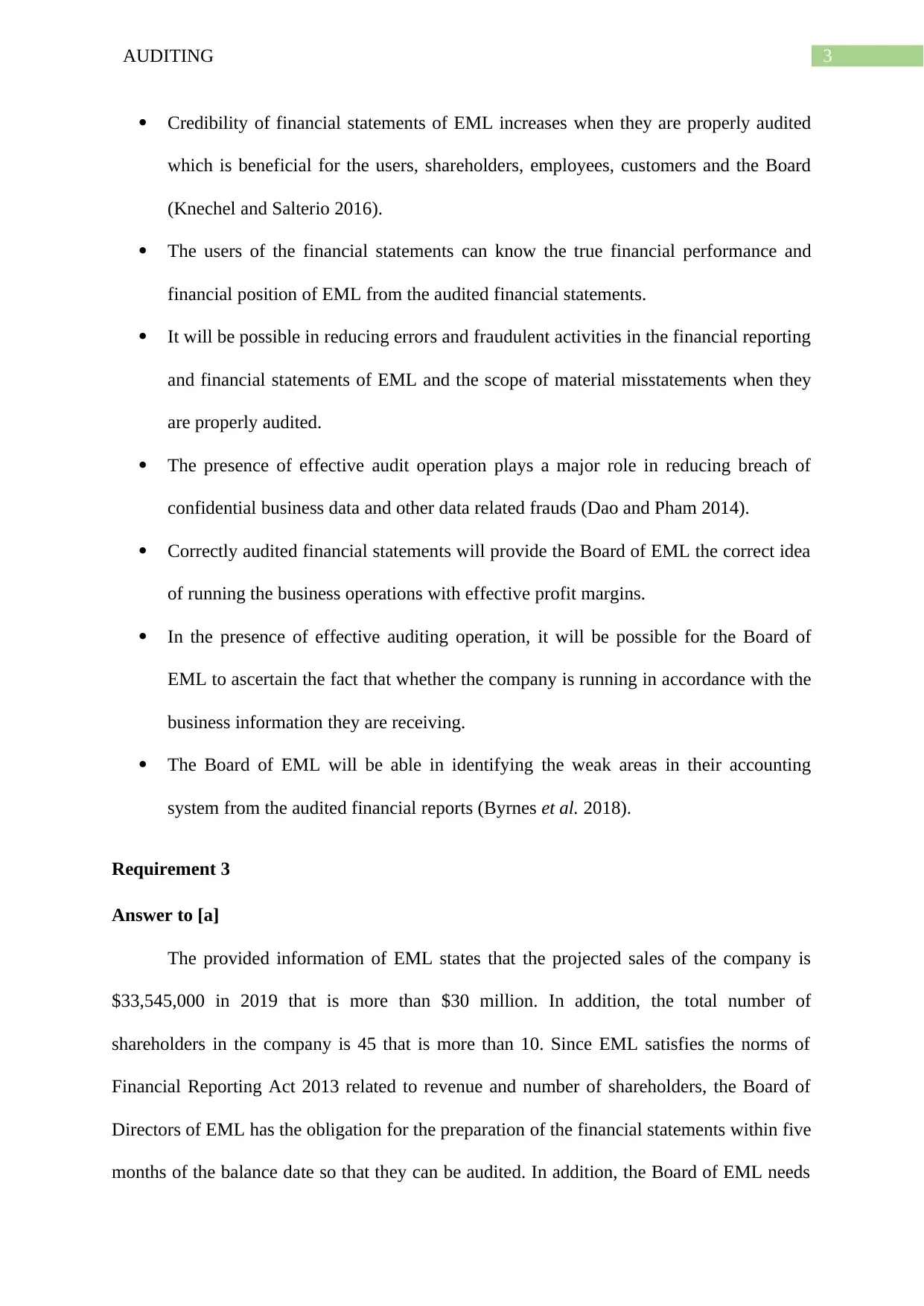
3AUDITING
Credibility of financial statements of EML increases when they are properly audited
which is beneficial for the users, shareholders, employees, customers and the Board
(Knechel and Salterio 2016).
The users of the financial statements can know the true financial performance and
financial position of EML from the audited financial statements.
It will be possible in reducing errors and fraudulent activities in the financial reporting
and financial statements of EML and the scope of material misstatements when they
are properly audited.
The presence of effective audit operation plays a major role in reducing breach of
confidential business data and other data related frauds (Dao and Pham 2014).
Correctly audited financial statements will provide the Board of EML the correct idea
of running the business operations with effective profit margins.
In the presence of effective auditing operation, it will be possible for the Board of
EML to ascertain the fact that whether the company is running in accordance with the
business information they are receiving.
The Board of EML will be able in identifying the weak areas in their accounting
system from the audited financial reports (Byrnes et al. 2018).
Requirement 3
Answer to [a]
The provided information of EML states that the projected sales of the company is
$33,545,000 in 2019 that is more than $30 million. In addition, the total number of
shareholders in the company is 45 that is more than 10. Since EML satisfies the norms of
Financial Reporting Act 2013 related to revenue and number of shareholders, the Board of
Directors of EML has the obligation for the preparation of the financial statements within five
months of the balance date so that they can be audited. In addition, the Board of EML needs
Credibility of financial statements of EML increases when they are properly audited
which is beneficial for the users, shareholders, employees, customers and the Board
(Knechel and Salterio 2016).
The users of the financial statements can know the true financial performance and
financial position of EML from the audited financial statements.
It will be possible in reducing errors and fraudulent activities in the financial reporting
and financial statements of EML and the scope of material misstatements when they
are properly audited.
The presence of effective audit operation plays a major role in reducing breach of
confidential business data and other data related frauds (Dao and Pham 2014).
Correctly audited financial statements will provide the Board of EML the correct idea
of running the business operations with effective profit margins.
In the presence of effective auditing operation, it will be possible for the Board of
EML to ascertain the fact that whether the company is running in accordance with the
business information they are receiving.
The Board of EML will be able in identifying the weak areas in their accounting
system from the audited financial reports (Byrnes et al. 2018).
Requirement 3
Answer to [a]
The provided information of EML states that the projected sales of the company is
$33,545,000 in 2019 that is more than $30 million. In addition, the total number of
shareholders in the company is 45 that is more than 10. Since EML satisfies the norms of
Financial Reporting Act 2013 related to revenue and number of shareholders, the Board of
Directors of EML has the obligation for the preparation of the financial statements within five
months of the balance date so that they can be audited. In addition, the Board of EML needs
Paraphrase This Document
Need a fresh take? Get an instant paraphrase of this document with our AI Paraphraser
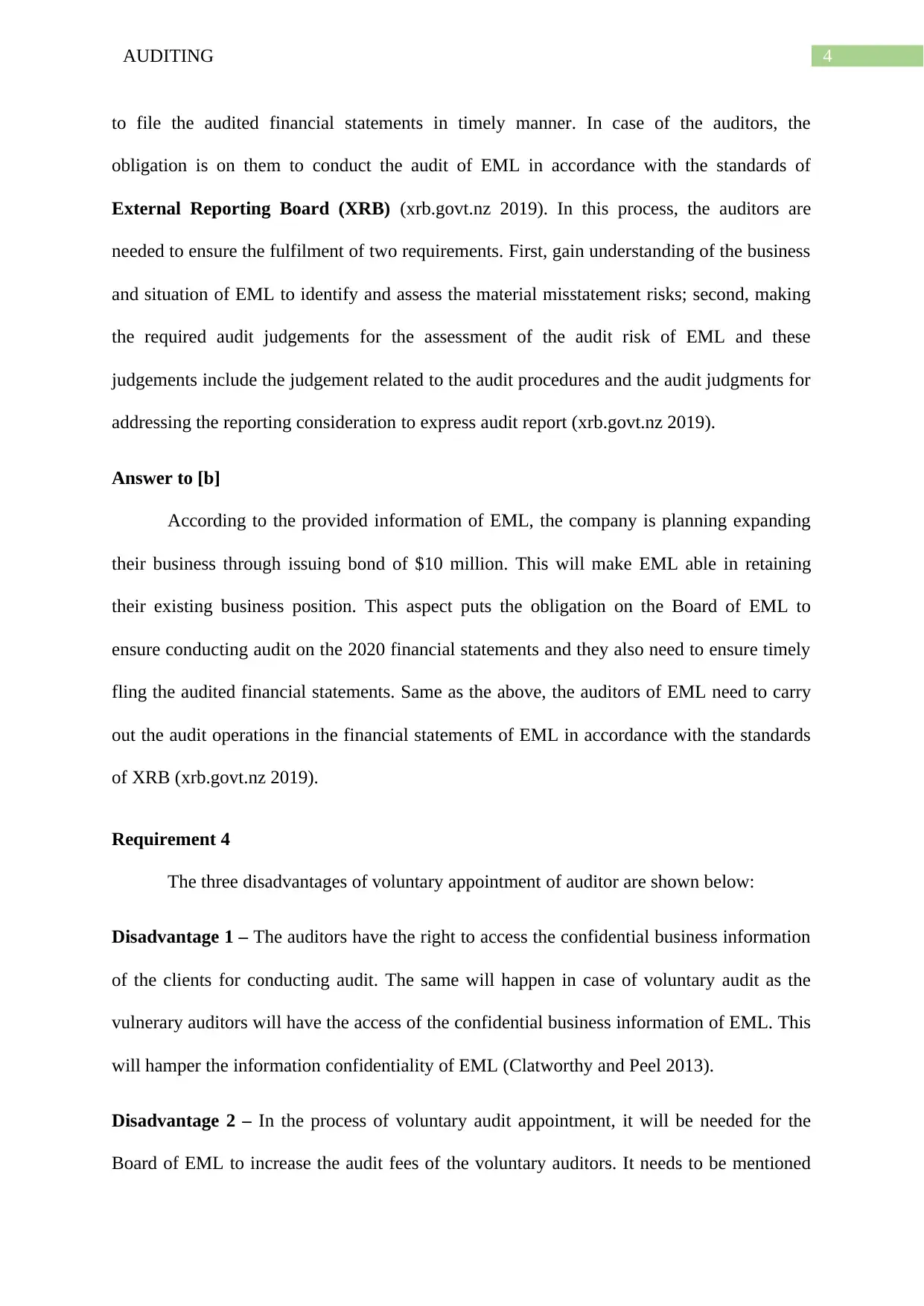
4AUDITING
to file the audited financial statements in timely manner. In case of the auditors, the
obligation is on them to conduct the audit of EML in accordance with the standards of
External Reporting Board (XRB) (xrb.govt.nz 2019). In this process, the auditors are
needed to ensure the fulfilment of two requirements. First, gain understanding of the business
and situation of EML to identify and assess the material misstatement risks; second, making
the required audit judgements for the assessment of the audit risk of EML and these
judgements include the judgement related to the audit procedures and the audit judgments for
addressing the reporting consideration to express audit report (xrb.govt.nz 2019).
Answer to [b]
According to the provided information of EML, the company is planning expanding
their business through issuing bond of $10 million. This will make EML able in retaining
their existing business position. This aspect puts the obligation on the Board of EML to
ensure conducting audit on the 2020 financial statements and they also need to ensure timely
fling the audited financial statements. Same as the above, the auditors of EML need to carry
out the audit operations in the financial statements of EML in accordance with the standards
of XRB (xrb.govt.nz 2019).
Requirement 4
The three disadvantages of voluntary appointment of auditor are shown below:
Disadvantage 1 – The auditors have the right to access the confidential business information
of the clients for conducting audit. The same will happen in case of voluntary audit as the
vulnerary auditors will have the access of the confidential business information of EML. This
will hamper the information confidentiality of EML (Clatworthy and Peel 2013).
Disadvantage 2 – In the process of voluntary audit appointment, it will be needed for the
Board of EML to increase the audit fees of the voluntary auditors. It needs to be mentioned
to file the audited financial statements in timely manner. In case of the auditors, the
obligation is on them to conduct the audit of EML in accordance with the standards of
External Reporting Board (XRB) (xrb.govt.nz 2019). In this process, the auditors are
needed to ensure the fulfilment of two requirements. First, gain understanding of the business
and situation of EML to identify and assess the material misstatement risks; second, making
the required audit judgements for the assessment of the audit risk of EML and these
judgements include the judgement related to the audit procedures and the audit judgments for
addressing the reporting consideration to express audit report (xrb.govt.nz 2019).
Answer to [b]
According to the provided information of EML, the company is planning expanding
their business through issuing bond of $10 million. This will make EML able in retaining
their existing business position. This aspect puts the obligation on the Board of EML to
ensure conducting audit on the 2020 financial statements and they also need to ensure timely
fling the audited financial statements. Same as the above, the auditors of EML need to carry
out the audit operations in the financial statements of EML in accordance with the standards
of XRB (xrb.govt.nz 2019).
Requirement 4
The three disadvantages of voluntary appointment of auditor are shown below:
Disadvantage 1 – The auditors have the right to access the confidential business information
of the clients for conducting audit. The same will happen in case of voluntary audit as the
vulnerary auditors will have the access of the confidential business information of EML. This
will hamper the information confidentiality of EML (Clatworthy and Peel 2013).
Disadvantage 2 – In the process of voluntary audit appointment, it will be needed for the
Board of EML to increase the audit fees of the voluntary auditors. It needs to be mentioned
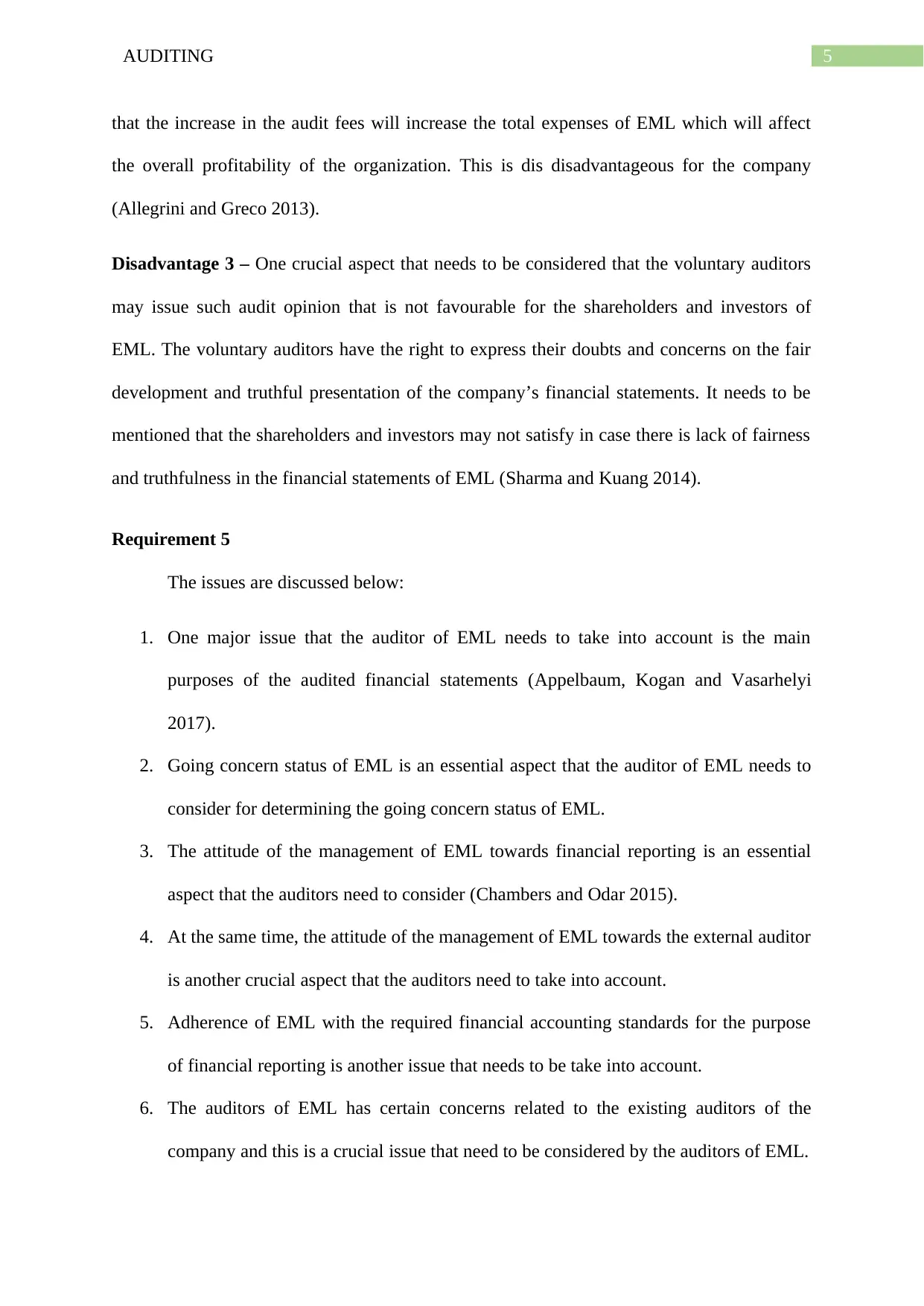
5AUDITING
that the increase in the audit fees will increase the total expenses of EML which will affect
the overall profitability of the organization. This is dis disadvantageous for the company
(Allegrini and Greco 2013).
Disadvantage 3 – One crucial aspect that needs to be considered that the voluntary auditors
may issue such audit opinion that is not favourable for the shareholders and investors of
EML. The voluntary auditors have the right to express their doubts and concerns on the fair
development and truthful presentation of the company’s financial statements. It needs to be
mentioned that the shareholders and investors may not satisfy in case there is lack of fairness
and truthfulness in the financial statements of EML (Sharma and Kuang 2014).
Requirement 5
The issues are discussed below:
1. One major issue that the auditor of EML needs to take into account is the main
purposes of the audited financial statements (Appelbaum, Kogan and Vasarhelyi
2017).
2. Going concern status of EML is an essential aspect that the auditor of EML needs to
consider for determining the going concern status of EML.
3. The attitude of the management of EML towards financial reporting is an essential
aspect that the auditors need to consider (Chambers and Odar 2015).
4. At the same time, the attitude of the management of EML towards the external auditor
is another crucial aspect that the auditors need to take into account.
5. Adherence of EML with the required financial accounting standards for the purpose
of financial reporting is another issue that needs to be take into account.
6. The auditors of EML has certain concerns related to the existing auditors of the
company and this is a crucial issue that need to be considered by the auditors of EML.
that the increase in the audit fees will increase the total expenses of EML which will affect
the overall profitability of the organization. This is dis disadvantageous for the company
(Allegrini and Greco 2013).
Disadvantage 3 – One crucial aspect that needs to be considered that the voluntary auditors
may issue such audit opinion that is not favourable for the shareholders and investors of
EML. The voluntary auditors have the right to express their doubts and concerns on the fair
development and truthful presentation of the company’s financial statements. It needs to be
mentioned that the shareholders and investors may not satisfy in case there is lack of fairness
and truthfulness in the financial statements of EML (Sharma and Kuang 2014).
Requirement 5
The issues are discussed below:
1. One major issue that the auditor of EML needs to take into account is the main
purposes of the audited financial statements (Appelbaum, Kogan and Vasarhelyi
2017).
2. Going concern status of EML is an essential aspect that the auditor of EML needs to
consider for determining the going concern status of EML.
3. The attitude of the management of EML towards financial reporting is an essential
aspect that the auditors need to consider (Chambers and Odar 2015).
4. At the same time, the attitude of the management of EML towards the external auditor
is another crucial aspect that the auditors need to take into account.
5. Adherence of EML with the required financial accounting standards for the purpose
of financial reporting is another issue that needs to be take into account.
6. The auditors of EML has certain concerns related to the existing auditors of the
company and this is a crucial issue that need to be considered by the auditors of EML.
⊘ This is a preview!⊘
Do you want full access?
Subscribe today to unlock all pages.

Trusted by 1+ million students worldwide
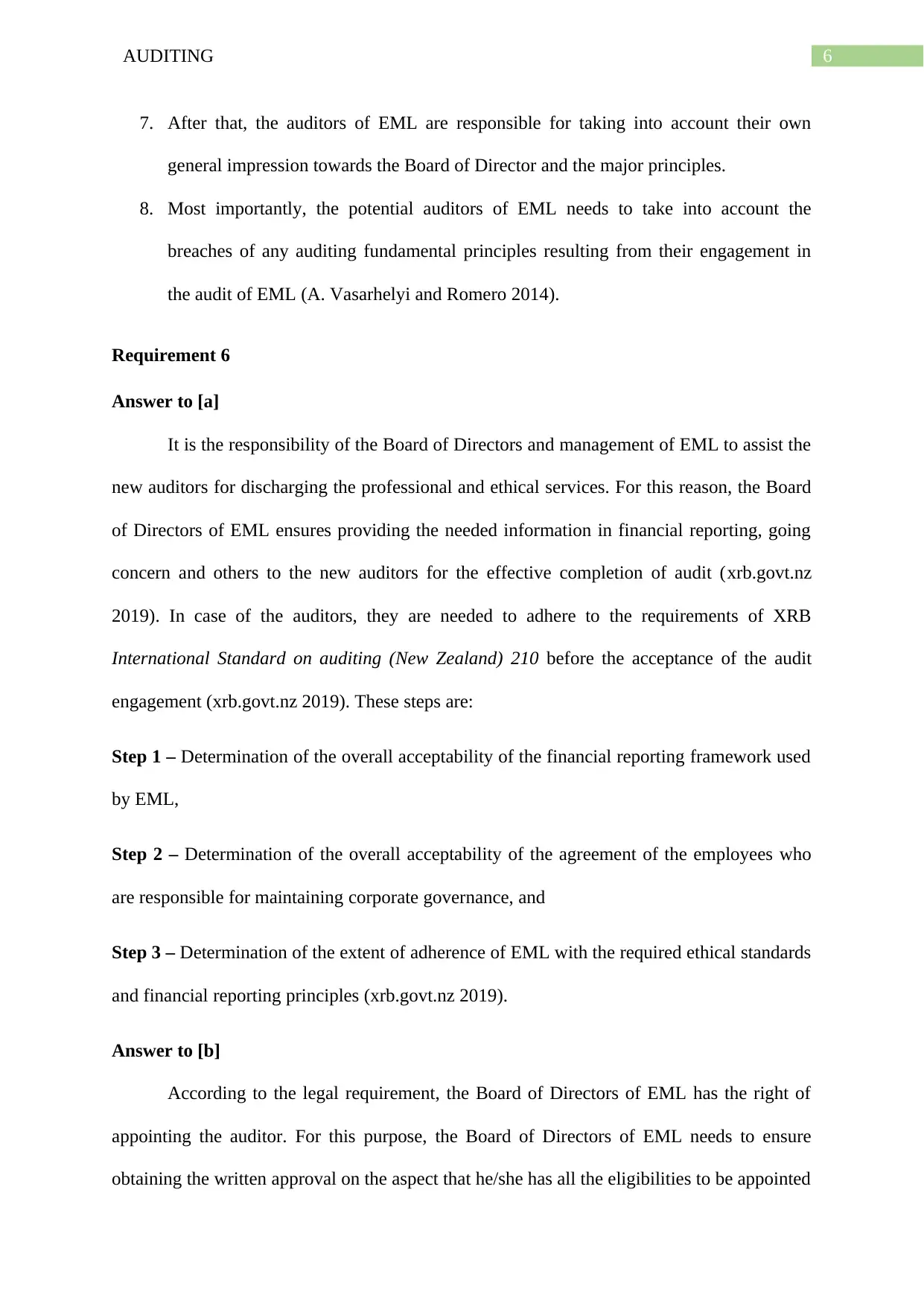
6AUDITING
7. After that, the auditors of EML are responsible for taking into account their own
general impression towards the Board of Director and the major principles.
8. Most importantly, the potential auditors of EML needs to take into account the
breaches of any auditing fundamental principles resulting from their engagement in
the audit of EML (A. Vasarhelyi and Romero 2014).
Requirement 6
Answer to [a]
It is the responsibility of the Board of Directors and management of EML to assist the
new auditors for discharging the professional and ethical services. For this reason, the Board
of Directors of EML ensures providing the needed information in financial reporting, going
concern and others to the new auditors for the effective completion of audit (xrb.govt.nz
2019). In case of the auditors, they are needed to adhere to the requirements of XRB
International Standard on auditing (New Zealand) 210 before the acceptance of the audit
engagement (xrb.govt.nz 2019). These steps are:
Step 1 – Determination of the overall acceptability of the financial reporting framework used
by EML,
Step 2 – Determination of the overall acceptability of the agreement of the employees who
are responsible for maintaining corporate governance, and
Step 3 – Determination of the extent of adherence of EML with the required ethical standards
and financial reporting principles (xrb.govt.nz 2019).
Answer to [b]
According to the legal requirement, the Board of Directors of EML has the right of
appointing the auditor. For this purpose, the Board of Directors of EML needs to ensure
obtaining the written approval on the aspect that he/she has all the eligibilities to be appointed
7. After that, the auditors of EML are responsible for taking into account their own
general impression towards the Board of Director and the major principles.
8. Most importantly, the potential auditors of EML needs to take into account the
breaches of any auditing fundamental principles resulting from their engagement in
the audit of EML (A. Vasarhelyi and Romero 2014).
Requirement 6
Answer to [a]
It is the responsibility of the Board of Directors and management of EML to assist the
new auditors for discharging the professional and ethical services. For this reason, the Board
of Directors of EML ensures providing the needed information in financial reporting, going
concern and others to the new auditors for the effective completion of audit (xrb.govt.nz
2019). In case of the auditors, they are needed to adhere to the requirements of XRB
International Standard on auditing (New Zealand) 210 before the acceptance of the audit
engagement (xrb.govt.nz 2019). These steps are:
Step 1 – Determination of the overall acceptability of the financial reporting framework used
by EML,
Step 2 – Determination of the overall acceptability of the agreement of the employees who
are responsible for maintaining corporate governance, and
Step 3 – Determination of the extent of adherence of EML with the required ethical standards
and financial reporting principles (xrb.govt.nz 2019).
Answer to [b]
According to the legal requirement, the Board of Directors of EML has the right of
appointing the auditor. For this purpose, the Board of Directors of EML needs to ensure
obtaining the written approval on the aspect that he/she has all the eligibilities to be appointed
Paraphrase This Document
Need a fresh take? Get an instant paraphrase of this document with our AI Paraphraser
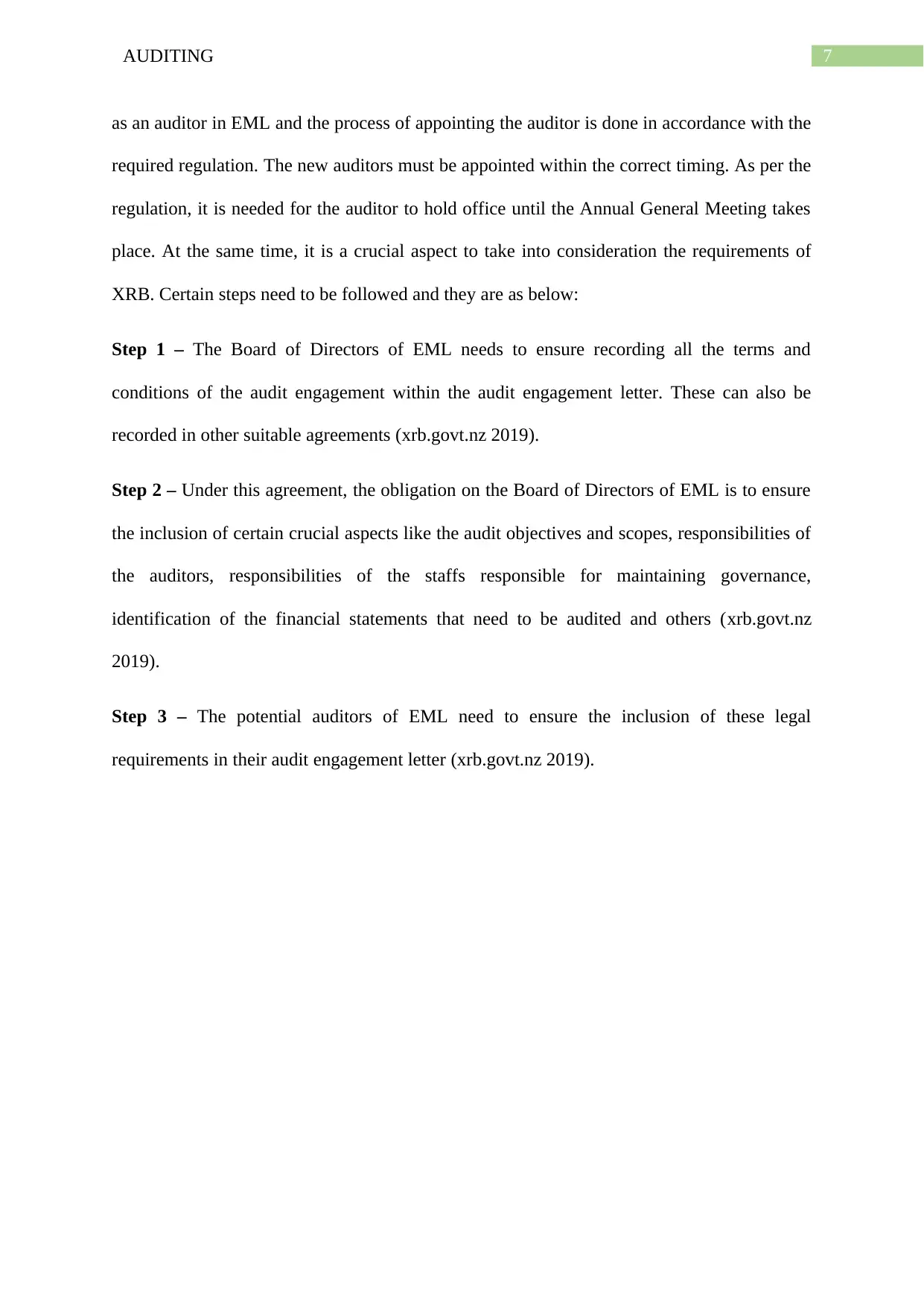
7AUDITING
as an auditor in EML and the process of appointing the auditor is done in accordance with the
required regulation. The new auditors must be appointed within the correct timing. As per the
regulation, it is needed for the auditor to hold office until the Annual General Meeting takes
place. At the same time, it is a crucial aspect to take into consideration the requirements of
XRB. Certain steps need to be followed and they are as below:
Step 1 – The Board of Directors of EML needs to ensure recording all the terms and
conditions of the audit engagement within the audit engagement letter. These can also be
recorded in other suitable agreements (xrb.govt.nz 2019).
Step 2 – Under this agreement, the obligation on the Board of Directors of EML is to ensure
the inclusion of certain crucial aspects like the audit objectives and scopes, responsibilities of
the auditors, responsibilities of the staffs responsible for maintaining governance,
identification of the financial statements that need to be audited and others (xrb.govt.nz
2019).
Step 3 – The potential auditors of EML need to ensure the inclusion of these legal
requirements in their audit engagement letter (xrb.govt.nz 2019).
as an auditor in EML and the process of appointing the auditor is done in accordance with the
required regulation. The new auditors must be appointed within the correct timing. As per the
regulation, it is needed for the auditor to hold office until the Annual General Meeting takes
place. At the same time, it is a crucial aspect to take into consideration the requirements of
XRB. Certain steps need to be followed and they are as below:
Step 1 – The Board of Directors of EML needs to ensure recording all the terms and
conditions of the audit engagement within the audit engagement letter. These can also be
recorded in other suitable agreements (xrb.govt.nz 2019).
Step 2 – Under this agreement, the obligation on the Board of Directors of EML is to ensure
the inclusion of certain crucial aspects like the audit objectives and scopes, responsibilities of
the auditors, responsibilities of the staffs responsible for maintaining governance,
identification of the financial statements that need to be audited and others (xrb.govt.nz
2019).
Step 3 – The potential auditors of EML need to ensure the inclusion of these legal
requirements in their audit engagement letter (xrb.govt.nz 2019).
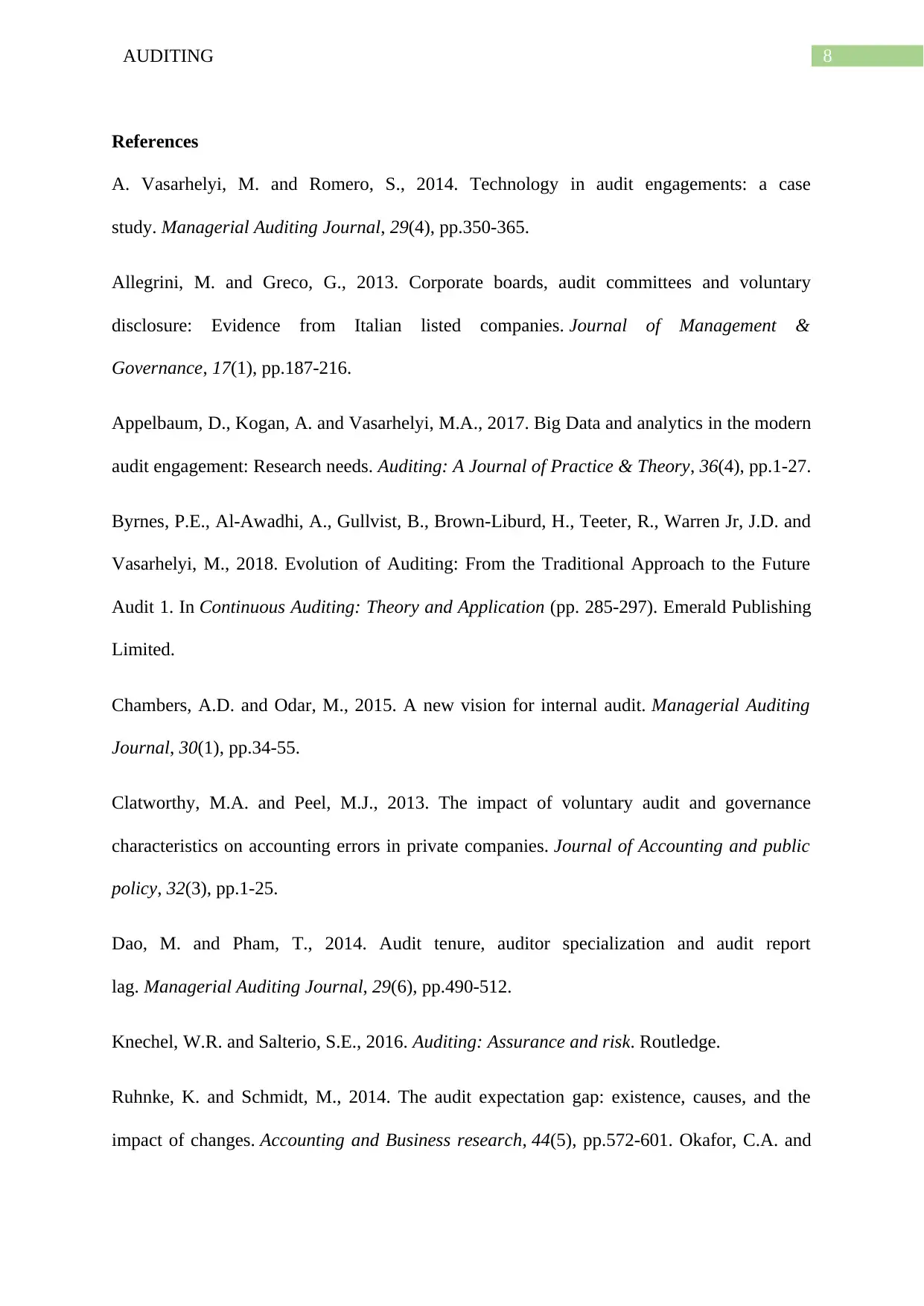
8AUDITING
References
A. Vasarhelyi, M. and Romero, S., 2014. Technology in audit engagements: a case
study. Managerial Auditing Journal, 29(4), pp.350-365.
Allegrini, M. and Greco, G., 2013. Corporate boards, audit committees and voluntary
disclosure: Evidence from Italian listed companies. Journal of Management &
Governance, 17(1), pp.187-216.
Appelbaum, D., Kogan, A. and Vasarhelyi, M.A., 2017. Big Data and analytics in the modern
audit engagement: Research needs. Auditing: A Journal of Practice & Theory, 36(4), pp.1-27.
Byrnes, P.E., Al-Awadhi, A., Gullvist, B., Brown-Liburd, H., Teeter, R., Warren Jr, J.D. and
Vasarhelyi, M., 2018. Evolution of Auditing: From the Traditional Approach to the Future
Audit 1. In Continuous Auditing: Theory and Application (pp. 285-297). Emerald Publishing
Limited.
Chambers, A.D. and Odar, M., 2015. A new vision for internal audit. Managerial Auditing
Journal, 30(1), pp.34-55.
Clatworthy, M.A. and Peel, M.J., 2013. The impact of voluntary audit and governance
characteristics on accounting errors in private companies. Journal of Accounting and public
policy, 32(3), pp.1-25.
Dao, M. and Pham, T., 2014. Audit tenure, auditor specialization and audit report
lag. Managerial Auditing Journal, 29(6), pp.490-512.
Knechel, W.R. and Salterio, S.E., 2016. Auditing: Assurance and risk. Routledge.
Ruhnke, K. and Schmidt, M., 2014. The audit expectation gap: existence, causes, and the
impact of changes. Accounting and Business research, 44(5), pp.572-601. Okafor, C.A. and
References
A. Vasarhelyi, M. and Romero, S., 2014. Technology in audit engagements: a case
study. Managerial Auditing Journal, 29(4), pp.350-365.
Allegrini, M. and Greco, G., 2013. Corporate boards, audit committees and voluntary
disclosure: Evidence from Italian listed companies. Journal of Management &
Governance, 17(1), pp.187-216.
Appelbaum, D., Kogan, A. and Vasarhelyi, M.A., 2017. Big Data and analytics in the modern
audit engagement: Research needs. Auditing: A Journal of Practice & Theory, 36(4), pp.1-27.
Byrnes, P.E., Al-Awadhi, A., Gullvist, B., Brown-Liburd, H., Teeter, R., Warren Jr, J.D. and
Vasarhelyi, M., 2018. Evolution of Auditing: From the Traditional Approach to the Future
Audit 1. In Continuous Auditing: Theory and Application (pp. 285-297). Emerald Publishing
Limited.
Chambers, A.D. and Odar, M., 2015. A new vision for internal audit. Managerial Auditing
Journal, 30(1), pp.34-55.
Clatworthy, M.A. and Peel, M.J., 2013. The impact of voluntary audit and governance
characteristics on accounting errors in private companies. Journal of Accounting and public
policy, 32(3), pp.1-25.
Dao, M. and Pham, T., 2014. Audit tenure, auditor specialization and audit report
lag. Managerial Auditing Journal, 29(6), pp.490-512.
Knechel, W.R. and Salterio, S.E., 2016. Auditing: Assurance and risk. Routledge.
Ruhnke, K. and Schmidt, M., 2014. The audit expectation gap: existence, causes, and the
impact of changes. Accounting and Business research, 44(5), pp.572-601. Okafor, C.A. and
⊘ This is a preview!⊘
Do you want full access?
Subscribe today to unlock all pages.

Trusted by 1+ million students worldwide
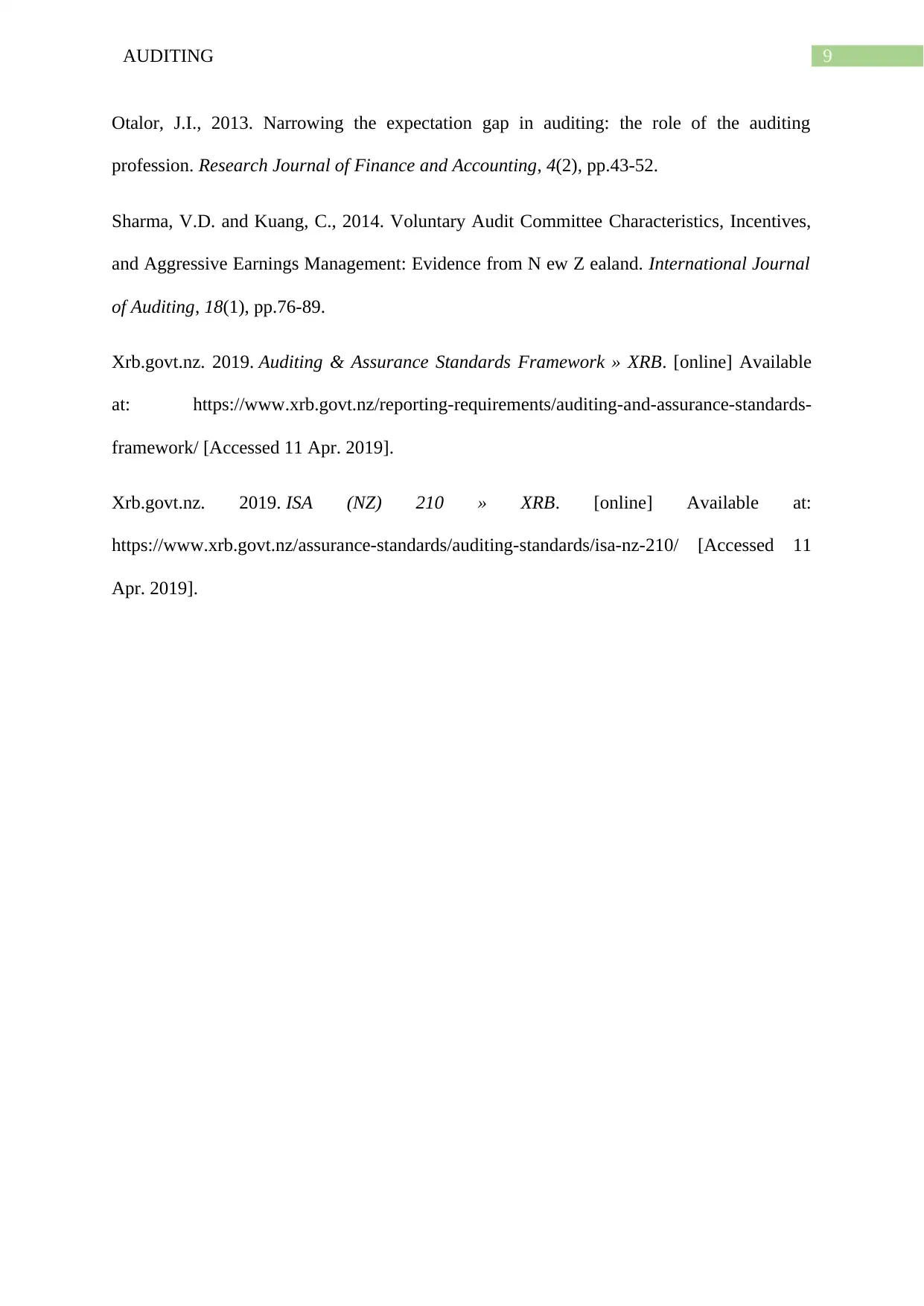
9AUDITING
Otalor, J.I., 2013. Narrowing the expectation gap in auditing: the role of the auditing
profession. Research Journal of Finance and Accounting, 4(2), pp.43-52.
Sharma, V.D. and Kuang, C., 2014. Voluntary Audit Committee Characteristics, Incentives,
and Aggressive Earnings Management: Evidence from N ew Z ealand. International Journal
of Auditing, 18(1), pp.76-89.
Xrb.govt.nz. 2019. Auditing & Assurance Standards Framework » XRB. [online] Available
at: https://www.xrb.govt.nz/reporting-requirements/auditing-and-assurance-standards-
framework/ [Accessed 11 Apr. 2019].
Xrb.govt.nz. 2019. ISA (NZ) 210 » XRB. [online] Available at:
https://www.xrb.govt.nz/assurance-standards/auditing-standards/isa-nz-210/ [Accessed 11
Apr. 2019].
Otalor, J.I., 2013. Narrowing the expectation gap in auditing: the role of the auditing
profession. Research Journal of Finance and Accounting, 4(2), pp.43-52.
Sharma, V.D. and Kuang, C., 2014. Voluntary Audit Committee Characteristics, Incentives,
and Aggressive Earnings Management: Evidence from N ew Z ealand. International Journal
of Auditing, 18(1), pp.76-89.
Xrb.govt.nz. 2019. Auditing & Assurance Standards Framework » XRB. [online] Available
at: https://www.xrb.govt.nz/reporting-requirements/auditing-and-assurance-standards-
framework/ [Accessed 11 Apr. 2019].
Xrb.govt.nz. 2019. ISA (NZ) 210 » XRB. [online] Available at:
https://www.xrb.govt.nz/assurance-standards/auditing-standards/isa-nz-210/ [Accessed 11
Apr. 2019].
1 out of 10
Related Documents
Your All-in-One AI-Powered Toolkit for Academic Success.
+13062052269
info@desklib.com
Available 24*7 on WhatsApp / Email
![[object Object]](/_next/static/media/star-bottom.7253800d.svg)
Unlock your academic potential
Copyright © 2020–2025 A2Z Services. All Rights Reserved. Developed and managed by ZUCOL.





